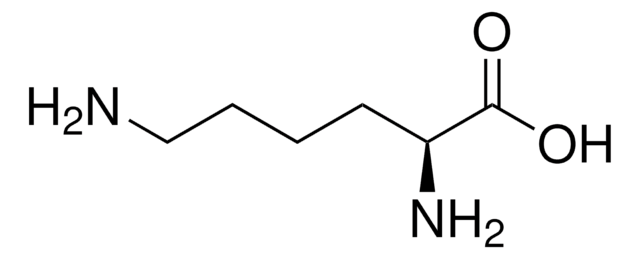62929
L-Lysine monohydrochloride
≥99.5% (AT), suitable for cell culture, BioUltra
Synonym(s):
(S)-2,6-Diaminohexanoic acid monohydrochloride
About This Item
Recommended Products
product name
L-Lysine monohydrochloride, BioUltra, ≥99.5% (AT)
product line
BioUltra
Quality Level
Assay
≥99.5% (AT)
form
powder or crystals
optical activity
[α]20/D +20.5±0.5°, c = 5% in 5 M HCl
technique(s)
cell culture | mammalian: suitable
impurities
insoluble matter, passes filter test
≤0.3% foreign amino acids
ign. residue
≤0.1% (as SO4)
loss
≤0.5% loss on drying, 20 °C (HV)
color
white
pH
5.0-6.0 (25 °C, 0.5 M in H2O)
mp
263 °C (dec.) (lit.)
solubility
H2O: 0.5 M at 20 °C, clear, colorless
anion traces
sulfate (SO42-): ≤100 mg/kg
cation traces
Al: ≤5 mg/kg
As: ≤0.1 mg/kg
Ba: ≤5 mg/kg
Bi: ≤5 mg/kg
Ca: ≤10 mg/kg
Cd: ≤5 mg/kg
Co: ≤5 mg/kg
Cr: ≤5 mg/kg
Cu: ≤5 mg/kg
Fe: ≤5 mg/kg
K: ≤50 mg/kg
Li: ≤5 mg/kg
Mg: ≤5 mg/kg
Mn: ≤5 mg/kg
Mo: ≤5 mg/kg
NH4+: ≤100 mg/kg
Na: ≤50 mg/kg
Ni: ≤5 mg/kg
Pb: ≤5 mg/kg
Sr: ≤5 mg/kg
Zn: ≤5 mg/kg
λ
0.5 M in H2O
UV absorption
λ: 260 nm Amax: 0.1
λ: 280 nm Amax: 0.1
SMILES string
OC([C@@H](N)CCCCN)=O.[H]Cl
InChI
1S/C6H14N2O2.ClH/c7-4-2-1-3-5(8)6(9)10;/h5H,1-4,7-8H2,(H,9,10);1H/t5-;/m0./s1
InChI key
BVHLGVCQOALMSV-JEDNCBNOSA-N
Looking for similar products? Visit Product Comparison Guide
General description
Application
- to study its effect on mRNA decay and destruction using mammalian cells
- to determine its effec on aTC1-6 cell proliferation
- to study the dynamics of the phosphoproteome upon amino acid supplement removal in the growth medium
Biochem/physiol Actions
Storage Class Code
11 - Combustible Solids
WGK
WGK 2
Flash Point(F)
Not applicable
Flash Point(C)
Not applicable
Personal Protective Equipment
Regulatory Listings
Regulatory Listings are mainly provided for chemical products. Only limited information can be provided here for non-chemical products. No entry means none of the components are listed. It is the user’s obligation to ensure the safe and legal use of the product.
JAN Code
62929-100G-F:
62929-500G-F:
62929-VAR-F:
62929-BULK-F:
Choose from one of the most recent versions:
Already Own This Product?
Find documentation for the products that you have recently purchased in the Document Library.
Customers Also Viewed
Our team of scientists has experience in all areas of research including Life Science, Material Science, Chemical Synthesis, Chromatography, Analytical and many others.
Contact Technical Service










